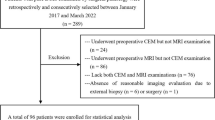Abstract
Background: This study was undertaken to establish the reliability of lymphoscintigraphy in indicating the number of sentinel nodes in patients with melanoma.
Methods: Lymphoscintigraphy was performed with dynamic imaging after injection of 60 MBq99mTc-nanocolloid (1.6 mCi) and static imaging after 2 hours in 200 patients with clinically localized primary melanoma of the skin. The following day, sentinel nodes were retrieved with the blue dye technique and a gamma detection probe (Neoprobe 1000/1500). The discrepancies between the number of sentinel nodes indicated by lymphoscintigraphy and the actual number of sentinel nodes as established by the surgeon were evaluated.
Results: Lymphoscintigraphy showed drainage to 393 sentinel nodes in 255 lymphatic fields in 199 patients. In 48 lymphatic fields (19%) in 46 patients (23%), the number of sentinel nodes was different from the number that was visualized with scintigraphy. Additional sentinel nodes were found by the surgeon because a lymphatic vessel was not seen on the lymphoscintigraphy (43%), because a sentinel node was not visualized separately from other hot nodes or vessels or the injection site (36%), or because a sentinel node was blue and not hot (4%). Fewer sentinel nodes were found than suggested by scintigraphy because a lymphangioma was mistaken for a sentinel node (4%) or because a single elongated node was depicted as two hot spots (6%).
Conclusions: Although lymphoscintigraphy is indispensable for lymphatic mapping, the predicted number of sentinel nodes is accurate in only 81% of lymph node fields. The limited discriminating power of the gamma camera is an important cause of discrepancies.
Similar content being viewed by others
References
Morton DL, Wen DR, Wong JH, et al. Technical details of intraoperative lymphatic mapping for early stage melanoma.Arch Surg 1992;127:392–9.
Wanebo HJ, Harpole DH, Teates CD. Radionuclide lymphoscintigraphy with technetium 99m antimony sulfide colloid to identify lymphatic drainage of cutaneous melanoma at ambiguous sites in the head and neck and trunk.Cancer 1985;55:1403–13.
Norman J, Cruse CW, Espinosa C, et al. Redefinition of cutaneous lymphatic drainage with the use of lymphoscintigraphy for malignant melanoma.Am J Surg 1991;162:432–7.
Uren RF, Howman-Giles RB, Shaw HM, Thompson JF, McCarthy WH. Lymphoscintigraphy in high-risk melanoma of the trunk: predicting draining node groups, defining lymphatic channels and locating the sentinel node.J Nucl Med 1993;34:1435–40.
Alex JC, Weaver DL, Fairbank JT, Rankin BS, Krag DN. Gammaprobe-guided lymph node localization in malignant melanoma.Surg Oncol 1993;2:303–8.
Kapteijn BAE, Baidjnath Panday RKL, Kroon BBR, et al. Identification of the first echelon lymph node in patients with melanoma [in Dutch].Ned Tijdschr Heelk 1995;4:159–63.
Van der Veen H, Hoekstra OS, Paul MA, Cuesta MA, Meijer S. Gamma probe-guided sentinel node biopsy to select patients with melanoma for lymphadenctomy.Br J Surg 1994;81:1769–70.
Thompson JF. Sentinel node biopsy.J Surg Oncol 1997;66:270–2.
Reintgen DS. Lymphatic mapping and sentinel node harvest for malignant melanoma.J Surg Oncol 1997;66:277–81.
Ross MI. Lymphatic mapping and sentinel node biopsy for early stage melanoma: how we do it at the M. D. Anderson Cancer Center.J Surg Oncol 1997;66:273–6.
Morton DL. Sentinel lymphadenectomy for patients with clinical stage I melanoma.J Surg Oncol 1997;66:267–9.
Nieweg OE, Jansen L, Kroon BBR. Technique of lymphatic mapping and sentinel node biopsy for melanoma.Eur J Surg Oncol 1998;24:520–4.
Haddad FF, Stall A, Messina JL, et al. The progression of melanoma nodal metastasis is dependent on tumor thickness of the primary lesion.Ann Surg Oncol 1999;6:144–9.
Gershenwald JE, Tseng CH, Thompson W, et al. Improved sentinel lymph node localization in patients with primary melanoma with the use of radiolabeled colloid.Surgery 1998;124:203–10.
Bostick P, Essner R, Glass E, et al. Comparison of blue dye and probe-assisted intraoperative lymphatic mapping in melanoma to identify sentinel nodes in 100 lymphatic basins.Arch Surg 1999;134:43–9.
Leong SP, Steinmetz I, Habib FA, et al. Optimal selective sentinel lymph node dissection in primary malignant melanoma.Arch Surg 1997;132:666–72.
Clary BM, Lewis JJ, Brady MS, Coit DG. The pattern of recurrence following sentinel lymph node biopsy in patients with melanoma [abstract].Eur J Nucl Med 1999;26:S58.
Schraffordt Koops H, Piers DA, Tiebosch A TMG, et al. Sentinel node biopsy in malignant melanoma of the skin [abstract].Eur J Nucl Med 1999;26:S57.
Kapteijn BAE, Nieweg OE, Liem IH, et al. Localizing the sentinel node in cutaneous melanoma: gamma probe detection versus blue dye.Ann Surg Oncol 1997;4:156–60.
Jansen L, Schraffordt Koops H, Nieweg OE, et al. Sentinel node biopsy for melanoma in the head and neck region.Head Neck 2000;22:27–33.
Jansen L, Nieweg OE, Peterse JL, Hoefnagel CA, Valdés Olmos RA, Kroon BBR. Reliability of sentinel node biopsy for staging melanoma.Br J Surg 2000;87:484–9.
Kirkwood JM, Strawderman MH, Ernstoff MS, Smith TJ, Borden EC, Blum RH. Interferon alfa-2b adjuvant therapy of high-risk resected cutaneous melanoma: the Eastern Cooperative Oncology Group Trial EST 1684.J Clin Oncol 1996;14:7–17.
Kirkwood JM, Ibrahim J, Sondak VK, et al. Role of high-dose IFN in high-risk melanoma: preliminary results of the E1690/S9111/C9190 US intergroup postoperative adjuvant trial of high and low-dose IFN-alfa-2b (HDI and LDI) in resected high-risk primary or regional lymph node metastatic melanoma in relation to 10-year updated results of E1684 [abstract]. Presented at the annual meeting of the European Society of Medical Oncology (ESMO), Athens, Greece, November 6–10, 1998.
Author information
Authors and Affiliations
Corresponding author
Rights and permissions
About this article
Cite this article
Jansen, L., Nieweg, O.E., Kapteijn, B.A.E. et al. Reliability of lymphoscintigraphy in indicating the number of sentinel nodes in melanoma patients. Ann Surg Oncol 7, 624–630 (2000). https://doi.org/10.1007/BF02725343
Received:
Accepted:
Issue Date:
DOI: https://doi.org/10.1007/BF02725343




